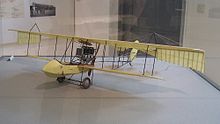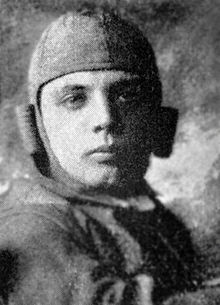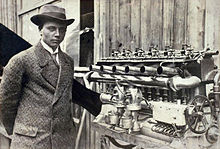Gustav Otto (aircraft manufacturer)
Gustav Otto (born January 12, 1883 in Cologne , † February 28, 1926 in Munich ) was a German aircraft manufacturer and a son of Nicolaus August Otto , after whom the gasoline engine is named.
Gustav Otto Flugmaschinenwerke
The aviation enthusiast Gustav Otto bought a Blériot monoplane as early as 1910 and received one of the first German pilot 's licenses with No. 34.
His Otto-Alberti aeroplane building was built in 1909 at Munich's Oberwiesenfeld , at the time a parade ground that Otto was allowed to use as an airfield in agreement with the Bavarian military authorities.
When co-founder Herbert Alberti left the company in 1911, the company was renamed Gustav Otto Flugmaschinenwerke . When the Royal Bavarian Air Force was founded in Schleissheim , Otto used his contacts with the military authorities and supplied the association with his double-deckers. These remained the standard aircraft of the young royal Bavarian air force until 1914, but they proved too weak for use at the front and were therefore used for training purposes. His company therefore had to stop manufacturing aircraft in 1915.
Otto then founded Otto-Werke GmbH in Munich and developed a bicycle with an auxiliary motor under the name "Flottweg". In the twenties motorcycles were manufactured and also sold under the name "Flottweg". In 1932 Georg Bruckmayer acquired the rights to the protected name "Flottweg" and founded the Flottweg-Motoren-Werke .
Gustav Otto also founded in Berlin-Johannisthal the AGO aircraft plants and supported the establishment of the Pfalz-Flugzeugwerke in Speyer .
In-house developments

- Otto-Alberti double decker (replica of the Farman double decker, model 1910)
- double decker
- Otto B.
- Otto BI
- Otto C
- Otto CI
- Otto C.II
In 1916 13 Otto CI were delivered to the Bulgarian Air Force, which was deployed on the southern front in Macedonia .
Two years after the outbreak of World War I , Gustav Otto Flugmaschinenwerke went bankrupt and the bankruptcy assets were then merged with Rapp Motorenwerke GmbH to form Bayerische Flugzeugwerke AG (BFW) in 1916 . This later resulted in BMW . In the same year Gustav Otto founded the Gustav Otto stock corporation in Oschersleben , which produced aircraft parts until the end of the war.
Otto then started a new attempt with the construction of motorcycles ("Flink" and "Helios"). But the inflation that set in after the end of the war , health problems and family setbacks put him in a hopeless situation. 1926 Otto committed at the age of 43 years suicide .
In the Flight Schleißheim since 2010 is a collaboration with the shipyard club featured an authentic and airworthy replica of a "Otto biplane military type 1913".
See also
literature
- Gustav Goldbeck: Otto, Gustav. In: New German Biography (NDB). Volume 19, Duncker & Humblot, Berlin 1999, ISBN 3-428-00200-8 , pp. 702 f. ( Digitized version ).
- Günter Kroschel, Helmut Stützer: The German military aircraft 1910–1918 , Wilhelmshaven 1977.
- Heinz Nowarra: The Development of Aircraft 1914-18 , Munich 1959.
- Karl R. Pawlas: German Aircraft 1914-18 , Pawlas Journalistic Archive, Nuremberg 1976, ISBN 3-88088-209-6 .
- Peter Pletschacher: The Royal Bavarian Air Force 1912-1919 , Motorbuch-Verlag, Stuttgart 1978, ISBN 3-87943-576-6 .
- G. Schmitt, W. Schwipps: Pioneers of early aviation , Gondrom Verlag, Bindlach 1995, ISBN 3-8112-1189-7 .
Web links
- Gustav Otto - pioneer of the Bavarian aviation industry. The Werftverein, October 30, 2004, archived from the original on August 7, 2016 ; accessed on July 6, 2018 (documentation on the exhibition).
- Gustav Otto. In: BMW history. BMW AG, accessed on July 6, 2018 (dossier in the BMW archive).
- Company history. Flottweg SE, accessed on July 6, 2018 (Flottweg company history).
- Detailed biography
Individual evidence
- ↑ today's Olympic Park
- ↑ The Oberwiesenfeld was used as an airfield until 1939, when flight operations were relocated to the then newly opened Munich-Riem Airport.
- ↑ a b Otto double-decker. In: Collections. Deutsches Museum - Flugwerft Schleissheim, accessed on November 23, 2012 .
- ↑ a b Peter Hanickel: Working Group Otto biplanes. Military type 1913. In: Der Werftverein. Association for the Preservation of the Historic Flugwerft, accessed on November 23, 2012 .
- ↑ S. Semerdjiev: Iron Cross over Bulgaria , Classics of Aviation, H. 3/2012, pp. 54–59.
| personal data | |
|---|---|
| SURNAME | Otto, Gustav |
| BRIEF DESCRIPTION | German aircraft manufacturer |
| DATE OF BIRTH | January 12, 1883 |
| PLACE OF BIRTH | Cologne |
| DATE OF DEATH | February 28, 1926 |
| Place of death | Munich |


